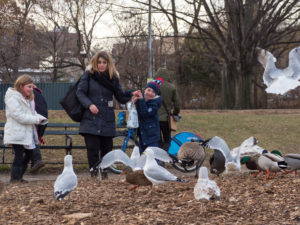By Dr. Beth Leermakers
Birding is one of the most popular, fastest growing outdoor recreational activities. More than 65 million Americans feed, watch and landscape their yard for birds. On Dec. 21, Audubon Dallas is holding its annual Christmas Bird Count (near Inwood Road and Cedar Springs).

Photo courtesy of Wikimedia Commons
Should You Feed
Wild Birds?
I always assumed that feeding wild birds was a good thing. I didn’t realize there can be a downside. The Audubon Society recommends asking these three questions before feeding wild birds:
Is this species at risk? To check a bird’s conservation status, consult Audubon’s Guide to North American Birds. (Source: audubon.org/bird-guide). If a bird is classified as “threatened,” “endangered” or “of special concern,” we should proceed with caution. Although our intentions are good, we may actually harm birds that are struggling to survive. For example, when people feed Florida Scrub-Jays (vulnerable to extinction), the birds reproduce earlier in the year than those that aren’t fed by humans. Unfortunately, the fledglings hatch before the caterpillars (their primary food source) are available, so the baby birds suffer from malnutrition and starvation.
Could feeding this bird change its behavior in harmful ways? Would feeding the bird draw it closer to the road, where it’s more likely to be hit by a car? Collisions with vehicles are a leading cause of death for owls, who fly low to the ground and slowly. Would feeding birds cause them to trust people, endangering them if they migrate to an area where they are hunted or not welcome?
Is the food appropriate and safely provided? Providing backyard bird feeders can spread viruses and parasites and increase the risk of window strikes and attacks by cats and raptors. One of the most popular foods, particularly for waterfowl, is also the least healthy. Bread offers little nutritional value and can cause “angel wing,” an unhealthy condition. Cracked corn or oats are a healthier choice.
If you choose to feed wild birds, follow these guidelines to safely set up and maintain feeders:
What to Feed Wild Birds
Provide different foods to attract a variety of birds. Put different food in different feeders. Black-oil sunflower seed appeals to the greatest number of birds.
Suet cakes (the raw, hard fat of beef or mutton found around the loins and kidneys) attract insect-eating birds such as woodpeckers, chickadees and wrens. Suet is particularly useful in cold weather, when birds need extra fat for warmth. In warm weather, use “no-melt” suet cakes that won’t turn rancid.
Mix five parts cornmeal with one part peanut butter. Stuff the mixture into holes in a log or crevices in pinecones. Peanut butter is a good warm weather alternative to suet.
Provide nectar (sugar solution: one part white sugar to five parts water) for hummingbirds. There’s no need to add red food coloring.
Empty and clean bird feeders twice a year (spring and fall). Clean them more often if you use them in humid weather. Uneaten seed can get soggy and moldy.
Keep Birds Safe
Place feeders within three feet of your windows — or more than 30 feet away — to reduce the risk of collisions. In the U.S., approximately one billion birds die from flying into windows each year.
To keep squirrels away from the food, place feeders on poles in an open area (at least 10 feet away from trees, shrubs and other tall objects). Pole-mounted feeders should be about five feet off the ground, with a cone-shaped baffle (at least 17” in diameter) under the feeder. Another option is to feed squirrels a cheaper food that appeals to them, in a separate feeder away from your bird feeders.
Keep your cat(s) inside. In the U.S., cats kill hundreds of millions of birds each year, pouncing on ground-feeding birds and those dazed by collisions with windows. Keeping your cats inside protects them from traffic, disease, predators (we have coyotes in my neighborhood!) and fights with other animals.
By following these guidelines, you can protect the birds and enjoy watching them. Happy birding!
